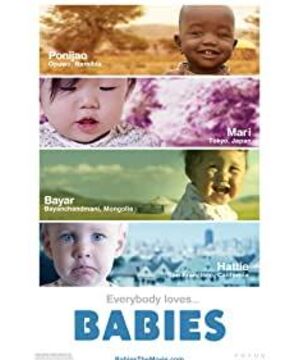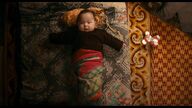"Sunshine Baby", downloaded on Pioneer in the previous stage. When I opened it, I couldn't remember the introduction, but I was hooked from the first minute. After the one hour and 20 minute film was over, I couldn't say a word, although I was amused countless times.
too full. too full.
This is a documentary that records the moments from birth to standing and walking of four babies in Namibia, Mongolia, Japan and the United States. It's all made up of details, no story, no conflict, no commentary, no leaning, not even dialogue. But it expresses too much.
Although there is no storyline, when it comes to structure, there are also vertical and horizontal lines. The vertical line is the growth process of the children, and the horizontal line is the comparison of children of four different races and different countries. Under the different natural environment and material development level, there are similar and different trajectories, such as prenatal preparation, birth, breastfeeding, bathing, weighing, parent-child activities, games, getting along with siblings, getting along with animals , the role of the father, etc.
Some of the details are interesting: before birth, the Namibian mother's round belly is covered with red paint; after birth, the Mongolian baby is tightly wrapped in a swaddle; in the bath, the Mongolian mother expresses milk to wash the baby's face, and the Namibian mother licks the baby with her tongue; games , Mongolian babies will play with themselves and giggle with themselves. Japanese babies have the most toys, but they are often unhappy and lose their temper; when they get along with animals, Japanese babies will cry in fear when they go to the zoo. The types of animals kept in Mongolian babies’ homes Many are family members. Namibian babies coexist peacefully with all animals such as puppies, ants and even flies, and all living beings are equal; in the role of fathers, Namibian fathers with groups of children have never appeared, and Mongolian fathers basically only attend family social occasions. In the coexistence of Japanese fathers and children, electronic products are always the third party, and American fathers put the most energy into it.
While watching, I can't help but compare, which baby is cuter, which education method is more reasonable, and which environment is more conducive to the healthy growth of the child's mind and body. What I feel most deeply is two points: first, material conditions do not mean happiness index; second, the so-called early education is a directional error that the human nature that has been gradually annihilated in urbanization is trying to return, and it will only drift away from the goal. , just deceiving oneself.
This film is recommended to everyone, whether you are a man or a woman, whether you have children or not, no matter where you live, whether you are happy or not.
Watching this documentary, you will feel a soft power in your heart.
View more about Babies reviews








